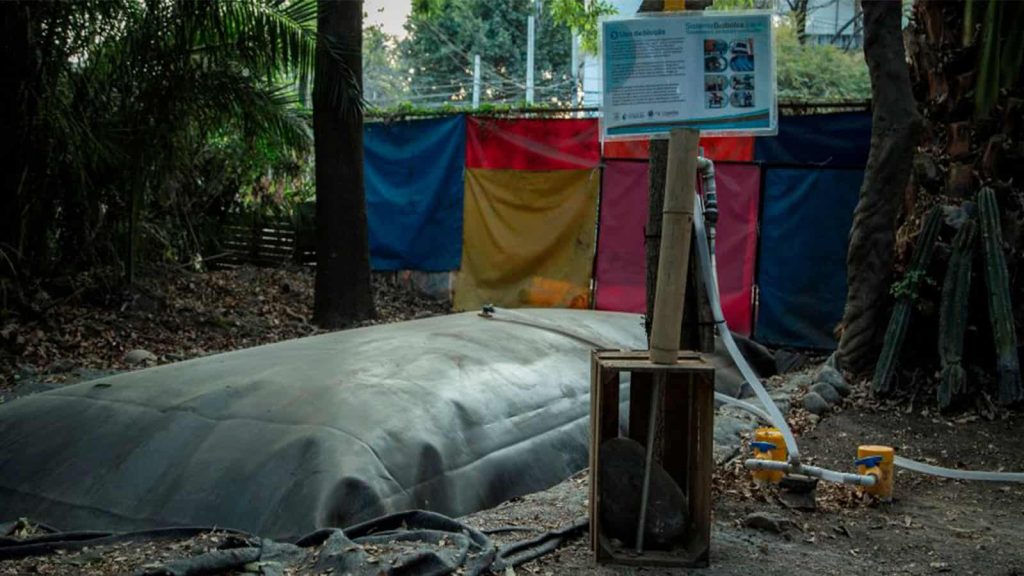In response to a massive global need for scalable sanitation solutions, Sistema.bio has optimized their waste treatment systems to work with human waste from households and community centers. Sistema.bio is the key component of a treatment technology chain that can eliminate the disease causing pathogens in human waste while creating biogas and nutrient rich soil enhancer.
There are numerous treatment technologies for human waste, but most of them are focused on sewered system with flush toilets for developed countries. Unfortunately, 2.7 billion are depending on onsite or decentralized sanitation technologies such as pit latrines. As a result, only 68% of the world’s population has access to basic sanitation, and only 39% has access to safely managed sanitation. Lack of proper sanitation causes diseases. Waterborne disease are a result of inadequate sanitation and hygiene practices. The World Health Organization states that every year more than 3.4 million people die as a result of water related diseases, making it the leading cause of disease and death around the world. (WHO 2009).
In the last 10 years Sistema.bio has installed hundreds of human waste fed systems all around the world and published several papers on the different treatment options and lessons learned. As a result, Sistema.bio is close to offering off the shelf biogas and biol producing solutions for human waste treatment.
Unlike the Sistema.bio’s animal waste fed systems, for a partly or fully human waste, fed system the Sistema reactor is the key component of a treatment chain that focuses on eliminating pathogens. The main reason for this is that human waste contains harmful pathogens. Depending on the location, Sistema.bio sanitation systems include a series of after treatment steps such as; aerated ponds, planted wetlands, urea treatment, sedimentation ponds etc. to prevent the spread of harmful pathogens and deathly diseases.
For biogas creating, all organic waste streams can be fed. But humans simply produce not so much waste per person. One cow can produce enough waste to create biogas for 1.5 hours of cooking per day, while the waste of one human will produces biogas for only 2 to 3 minutes per day. For a significant biogas production Sistema.bio recommends to feed these systems by either human plus animal waste or the human waste of multiple toilets to increase the amount.
The Sistema.bio reactors also produce nutrient rich biol, the effluent that can be used to fertilize crops. Unfortunately, the nutrient levels in human waste are relatively low. The human digestive system is very efficient in compare with for example a cow and therefore more of the nutrient intake is used up by the body itself. Also, humans produce less waste. One cow produces over half a kilogram of nitrogen per day, while humans produce around the 10 grams of nitrogen per day. Sistema.bio recommends to mix the waste streams for feeding in order to optimise the nutrient levels in the biol. The Sistema.bio reactors do increases the usability of the nutrients and makes it easier for the farmer to apply and easier for the plants to reach the nutrients.
The Sistema.bio sanitation products are divided into two main segments: household co-digestion systems that receive both human as well as animal manure and community systems that receive human waste exclusively from 50+ people per day. One of the community systems is at the community center Huerto Roma Verde (HRV) in Mexico City.
Show sanitation case Huerto Roma Verde in Mexico City
In October 2016 the HRV and Sistema.bio worked together to implement a solution that allows to treat the wastewater generated by approximately 500 visitors per week, transform the organic matter into biogas, to generate a liquid with a high nutritive value and reduced pathogen content to be used locally as a fertilizer. The waste comes from toilets and two urinals and discharges to a series of two hybrid reactors and three open tanks. A pump recirculates the water from the last tank to the first one while air is being injected into different tank sections.
The water from the sink of the sanitary block goes to a grease trap and then directly to the first open tank. The third open tank presents an overflow where the water is spread over a gravel bed. The biogas is used for a double burner cook stove to heat water or cook meals. The easiness of installation allowed to install the full system within three working days. The effluent recirculation and aeration in the three post treatment ponds allows a further pathogen reduction and to eradicate the odor generation from the effluent. The overall pathogen treatment was assessed through E.Coli analysis and showed an overall reduction of over 91% and the absence of Helminth eggs in the effluent water. The installation achieves an overall removal of 80% of volatile solids and an expected increase of ammonia and total phosphorus, of 550% and 35% respectively. The installation has been consistently producing biogas since its startup with a production that has been estimated at 0.40 Nm3 per day. The Biogas analysis showed that the produced gas was of high quality with 55% of methane content.
